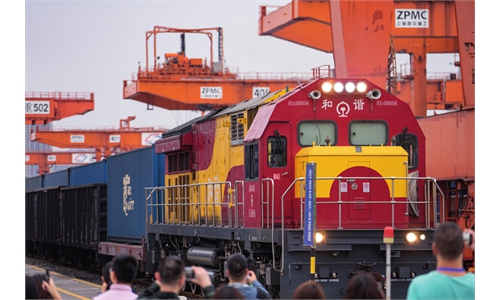
Illustration: Chen Xia/Global Times
There has been a lot of discussion about the rise or fall of China-US trade, but less attention has been paid to another important participant in global industry chains - Southeast Asia. A Bloomberg article said Monday that for the first time, China exported more to Southeast Asia in 2023 than to the US. If Bloomberg's report is true, the news can be seen as a new milestone for the realignment of global trade.Chinese customs data showed that ASEAN emerged as China's largest export market in 2023, with an annual value reaching $523.7 billion. The US, which held the top spot in 2022, slid to third place in 2023 with $500.3 billion, down 13.1 percent from the previous year.
The realignment of global trade is the result of many factors, such as rising US trade protectionism, unilateral and anti-market suppression and economic bullying, which are threatening not only China but also the global economy.
In a world undergoing drastic changes, both challenges and opportunities exist. Washington has been trying to squeeze China out of global supply chains through a series of approaches in the name of "de-risking," but trade data suggest things are going in the opposite direction of what people expected. China has integrated deeper into global supply chains, established an open and cooperative system, and further opened up its manufacturing sector to counter combined challenges.
Research by economists showed that goods that were supposed to be processed in China and exported to the US are now subject to increasingly complex delivery routes: China now exports more high value-added intermediate products to Southeast Asia, India, Mexico and other countries for final assembly, and then re-exports them to the US.
In the past, China imported core components and assembled them into final products for export. The volume was relatively high but the profits made by assembly lines were limited. Now, China has made itself an important exporter of intermediate products. China's exports to the US have declined, but as China's companies move up the industry value chain, they can earn more money.
In recent years, some manufacturers have been shifting parts of their assembly lines out of China to Southeast Asia and other regions, but they still import intermediate products from China. This fosters closer industry chain cooperation between China and those countries.
As for Southeast Asia and other regions, more imports mean more trade deficits. However, taking a closer look at their foreign trade structures, a noteworthy part is intermediate products. It brings opportunities for industrialization, rather than substitutes for manufacturing products in the local market.
However, some people in countries especially India hold a negative attitude toward Chinese-made products and trade deficits with China. With a zero-sum mentality, they may miss out on the opportunities created by supply chain restructuring. China and those countries enjoy strong complementarity in strengthening economic cooperation. We should seize the opportunity.
Although ASEAN has reportedly surpassed the US as China's largest export market, the US, at least in the short term, remains an important final consumer market, as some of China's exports to Southeast Asia will eventually be re-exported to the US. This reality reminds China and its trade partners to diversify their markets.
Amid a decline in external demand, companies doing businesses in China are focusing more on Chinese domestic consumer markets. Chinese authorities in 2023 issued 20 measures to boost domestic consumption, including support for expanding real estate and auto sales, underscoring the country's intensifying efforts to ensure a steady economic recovery.
China has made itself an important final consumer market in the world. This will promote industry chain cooperation between China and Southeast Asia from another perspective.
The author is a reporter with the Global Times. bizopinion@globaltimes.com.cn



